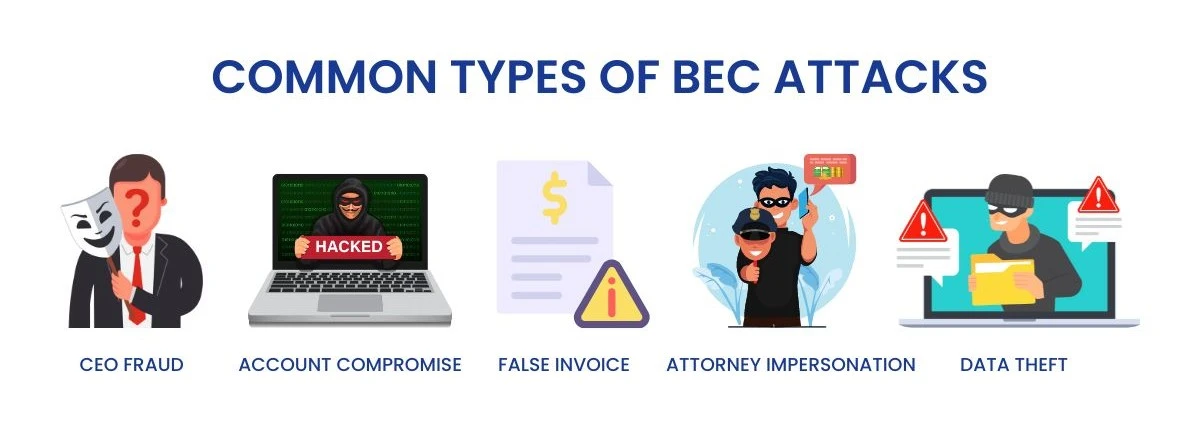Every year many organizations become the victim of BEC attacks in which attackers target trusted email accounts to manipulate employees, partners of the company and convince them to transfer monetary funds or reveal the company’s confidential details. This results in heavy financial losses and huge reputational damages. There are many tools and solutions available to reduce BEC attacks but lack the features to tackle modern cyber threats and are limited to identifying and reporting fake email IDs. To solve such issues there is a need to understand the workings of BEC attacks and implement solutions which have advanced capabilities to deal with modern threats.
Table of Contents
ToggleWhat is Business Email Compromise (BEC)?
BEC stands for Business Email Compromise. In this type of attack, the Hacker impersonates the real owner of the email account to defraud the organization, its employees, and its customers into sending confidential data or monetary funds to attackers. BEC attacks involve extensive research in which attackers collect the details about the company through websites, social media handles, press releases, and other publicly available platforms. Attackers collect the details of senior executives and employees and will try to gain access through executive’s email accounts. Hackers can also create fake email accounts or spoof domains which are similar to the original account to carry out impersonation attacks as well.
Various individuals within the organization are targeted through BEC attacks.
- Senior level Executives
- Account personnel
- HR Managers
- Entry level Employees
Common Types of BEC Attacks
-
- CEO fraud: Attackers impersonate senior-level executives or company executives to trick employees into revealing sensitive details of the organization such as login credentials, company data and financial details.
- Account Compromise: Sensitive company details and payment requests can be made by hackers if they gain access to employee’s email IDs
- False invoice scam: Fraudulent or altered invoices are used in these types of scams and are used to redirect payments to fraudsters.
- Attorney impersonation: Hackers use impersonation techniques to pose as legal representatives to request payment transfers.
- Data Theft: Scamsters target the HR department to steal confidential details of the company for conducting future attacks.

Real-life Incidents of BEC Attacks
- Ubiquiti (June 2015)
It is a networking company targeted by BEC scams in which hackers impersonated vendors which resulted in a $46.7 million loss. These attacks happened due to the presence of vulnerabilities in the payment gateway and highlighted the need for stronger security measures.
Reference: Tripwire.com
- FACC (Jan 2016)
This Austrian aerospace company was defrauded for $54 million by an email impersonating the CEO of the company. This attack raised the need for leadership-level cybersecurity training and also demanded the requirement of establishing multi-factor verification to detect unauthorized access and impersonation attempts.
Reference: securityweek.com
Various Techniques used by hackers for initiating BEC Attacks
- Domain Spoofing: In this type of cyberattack hackers use fake domains to appear as legitimate users.
- Pretexting: In this method, hackers create a fabricated scenario to trick company executives into providing financial details or company confidential details.
- Social engineering: It is used to manipulate, deceive, and influence victims to reveal sensitive information or compromise security.
- Link Manipulation: Attackers send fake emails to the victim which contain malicious links and direct to fake websites which collect sensitive details such as login credentials, accounts details, and financial information.
Prevention Strategy to avoid BEC attacks.
- Organizations need to implement DMARC, SPF, and DKIM techniques to make email authentication easier by verifying email sources.
- Setting up real-time notification alerts can help to detect unusual email activity.
- Providing security awareness training to employees to make them ready against various BEC attacks.
- There is a need to conduct audits on a regular basis to ensure compliance with security policies and identify potential vulnerabilities that can affect the security posture of the organization.
- Implementing technologies like AI and machine learning can help detect anomalies in email patterns and flag potential BEC attempts.
- It demands the need of developing and regularly updating incident response plan to quickly address BEC attempts.
- There is a need to encourage users to check and avoid clicking on suspicious links or attachments from unknown senders.
Book a Free Demo Call with Our People Security Expert
Enter your details
Threatcop’s Approach to Tackle BEC Attacks
Focusing on modern email requirements and protecting organizations from these email threats, Threatcop has introduced TDMARC which helps organizations to protect outbound email workflow from spoofing and phishing attacks. It offers features like smart SPF, smart DKIM, and BIMI record management to maintain the confidentiality of the organization’s sensitive data. Threat identification and monitoring process becomes easy through IP blacklisting and mitigation of lookalike domains.
Benefits of using TDMARC in tacking BEC attacks
Here are the benefits of using TDMARC mentioned below:-
- Help to protect the outbound email workflow of the organization.
- Simplify the email authentication process by preventing unauthorized access and spoofing attempts.
- Identification and mitigating lookalike domains become easier.
- Offers integration with various apps like Teams, Slack, Google Chat and Emails.
- Uses smart SPF and smart DKIM techniques for advanced email security.
- IP blacklisting and monitoring streamline the analysis and verification procedure.
- Adds an extra layer of security by using IAM,2FA, and SSO login.
- Offers detailed reports on geolocation, compliance, and source analysis.
Why choose Threatcop’s TDMARC over other DMARC solutions?
There are many traditional DMARC solutions available in the market but lack modern needs as it is just too limited in monitoring and visibility. To meet the future requirements Threatcop’s TDMARC uses the power of technology to enhance email security posture. With features like smart SPF and smart DMARC, it is easier to manage or make changes in the dashboard, and also reflects automatically into your DNS.
By using these features there is no need to go back again and again to make changes. It also has unique exclusive features like MTA-STS, Smart BIMI, lookalike domain visibility, SIEM integration, real-time notifications, and more to make the organization future-ready against various types of business email compromise attacks.
Conclusion
Business email is one of the continuously growing threats which has resulted in many organization’s financial and reputational damage. To stop the misuse of confidential data, organizations need to adopt an advanced email authentication and security solution like TDMARC which will help to reduce spoofing and phishing attacks. Its features like smart SPF, smart DKIM, MTA-STS, Smart BIMI, lookalike domain visibility, SIEM integration, real-time notification, and many more others help organizations tackle modern cyberattacks. It helps to strengthen security posture by protecting outbound email workflow and reducing the chances of becoming a victim of BEC attacks.

Technical Content Writer at Threatcop
Milind Udbhav is a cybersecurity researcher and technology enthusiast. As a Technical Content Writer at Threatcop, he uses his research experience to create informative content which helps audience to understand core concepts easily.
Technical Content Writer at Threatcop Milind Udbhav is a cybersecurity researcher and technology enthusiast. As a Technical Content Writer at Threatcop, he uses his research experience to create informative content which helps audience to understand core concepts easily.
